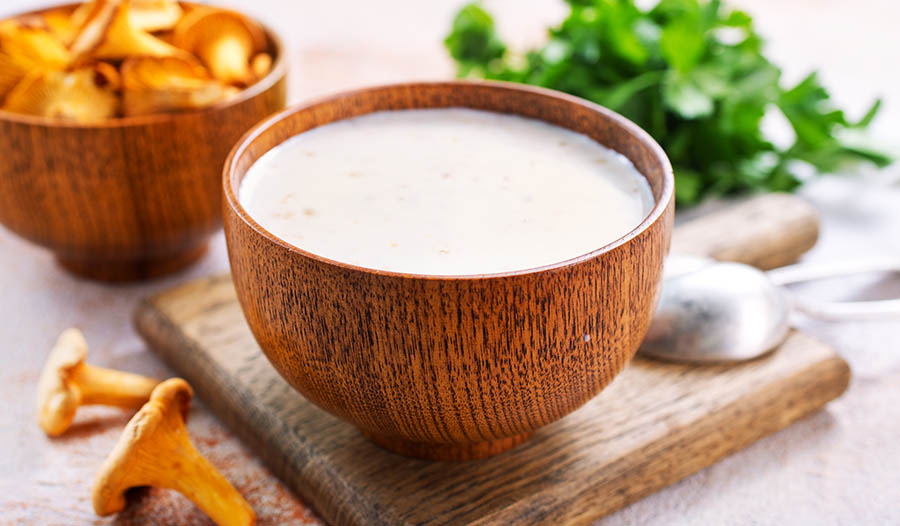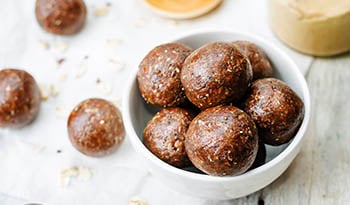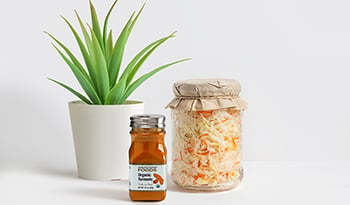6 Functional Mushroom Types: Benefits, Coffee Alternative Recipes, More
DISCLAIMER:This blog does not intend to provide diagnosis...
- In this article:
- Nutritional Benefits of Mushrooms
- Types Of Functional Mushrooms And Their Health Benefits
- 1. Reishi (Ganoderma lucidum)
- 2. Shiitake (Lentinula edodes)
- 3. Chaga (Inonotus obliquus)
- 4. Cordyceps
- 5. Lion’s Mane (Hericium erinaceus)
- 6. Turkey Tail (Coriolus versicolor)
- Mushroom Coffee: A Healthy Alternative Packed with Benefits
- Pumpkin Spice Mushroom Latte Recipe
- Maca Mushroom Latte Recipe
- Bulletproof Mocha Mushroom Latte Recipe
- Iced Mushroom Matcha Latte Recipe
- Golden Mushroom Latte Recipe
- Classic Mushroom Latte
- Iced Mushroom Coffee Recipe
- Classic Hot Mushroom Coffee Recipe
- Hot Mushroom Coco Drink Recipe

Originally posted January 2019 / Updated August 2023
In food and medicine, mushrooms have stood the test of time. However, in the present moment, their popularity is skyrocketing, particularly those varieties that offer "functional" health benefits.
The global functional mushroom market, estimated at over $25 billion, is booming. It is expected to grow over 10% annually until 2030.
This growth represents the significant increase in the popularity of functional mushrooms as both food and dietary supplements due to their numerous health benefits.
For many years, the most popular functional mushrooms were shitake and reishi. While these two mushrooms have become even more popular recently because of their immune-boosting effects, the growth of the total functional mushroom market is greatly influenced by other health-promoting mushrooms' emergence. The following types of mushrooms have immune-enhancing effects as well as additional health benefits:
- Cordyceps for supporting endurance, stamina, and energy levels.
- Lion’s mane for boosting mood, overall brain health, and memory.
- Chaga and turkey tail for immune support and antioxidant effects.
Nutritional Benefits of Mushrooms
Mushrooms are rich in bioactive compounds such as beta-glucans, flavonoids like quercetin, and other polyphenols and triterpenes. The health benefits of these ingredients are well-established. But even more exciting is the emerging data on the unique amino acid ergothioneine (ERGO).
Ergothioneine is an anti-aging and health-promoting amino acid produced by mushrooms. Dr. Bruce Ames, a famous scientist at the University of California, has suggested that ERGO be considered a “longevity vitamin” based on extensive research.
ERGO is a thiol, meaning it is a sulfur-containing compound. Some of its antioxidant and anti-aging effects are similar to other thiol-containing compounds, such as glutathione and coenzyme Q10. Still, since ERGO is a much smaller molecule, it is distributed throughout the body and all the compartments of the cells, including the mitochondria (the energy-producing compartment of cells).
ERGO has decreased oxidative stress in virtually every tissue and cell type studied, including the lining of blood vessels, liver, kidney, heart, and other organs. It also helps reduce the toxic effects of many harmful chemicals.
Lower intakes of ERGO from the diet may explain why Americans have more age-related health issues and a lower life expectancy than other countries. For example, the estimated intake level of ERGO in the United States is 1.1 mg/day compared to up to 4.6 mg/day in Italy.
In a study of over 15,000 Americans, researchers found that individuals who consumed even small amounts of mushrooms were associated with a 16% reduction in mortality rate. ERGO may be the critical mushroom component for this benefit.
Mushrooms are the critical dietary source of ERGO, representing about 95% of the total dietary intake. And if a person is not regularly eating mushrooms, they are likely deficient in ERGO. And evidence indicates that it could accelerate aging and the development of age-related disorders.
Types Of Functional Mushrooms And Their Health Benefits
1. Reishi (Ganoderma lucidum)
Interestingly, reishi mushrooms were called the "mushroom of immortality" in traditional Chinese medicine. How did these ancient Chinese know it was rich in ERGO?
Reishi mushrooms are like a factory of biologically active valuable compounds. Most importantly, they are rich in beta-glucans that promote immune function and triterpene, which can exert antioxidant and anti-aging effects, boost moods, reduce feelings of anxiety, and improve sleep.
2. Shiitake (Lentinula edodes)
Though the shiitake mushroom is a mainstay in the Japanese diet, it grows in the warm, humid regions of North and South America, Asia, and Australia.
Scientific research has focused on immune-enhancing polysaccharides, though these compounds also exert antioxidant and anti-aging effects.
3. Chaga (Inonotus obliquus)
Chaga mushrooms grow on many tree species, particularly birch trees. The appearance of the dark brown Chaga mushrooms on a tree can look like a burnt clump of bark.
Like other mushrooms, chaga exerts immune-enhancing, antioxidant, and anti-aging properties. Chaga has also shown some anti-fatigue effects.
4. Cordyceps
Cordyceps encompass more than 400 species of mushrooms, but C. sinensis and C. militaris are the types most often researched and used in supplements.
Cordyceps is a nutrient and phytochemical-rich mushroom most commonly used to reduce fatigue and to boost strength. Like many other functional mushrooms, they may also slow aging.
5. Lion’s Mane (Hericium erinaceus)
Lions mane mushrooms are large white mushrooms with many long white spines resembling a lion’s mane. Typically, they are grown on dead and decaying hardwood or can be grown on a home substrate.
Like most mushrooms, lion’s mane contains polysaccharides that can support immune function. However, the primary use is in supporting brain function and mood. Lion’s mane contains compounds known as erinacines that can pass through the blood–brain barrier to promote improved brain cell function, resulting in mood, memory, and cognition improvements.
6. Turkey Tail (Coriolus versicolor)
Turkey's tail was named because of the mushroom's bright colors and resemblance to a turkey tail. These can be found growing on tree trunks in wooded areas.
Turkey tail is most often used for its immune-enhancing and antioxidant properties because it may have compounds that may stimulate and strengthen the immune system.
Mushroom Coffee: A Healthy Alternative Packed with Benefits
Mushroom-based drink mixes are one of the most common ways to supplement with mushrooms and are an excellent herbal alternative to traditional coffee, tea, and cocoa.
Typically, these products are dried powdered mixes available as bulk powder or in packets for single-serving use. Generally, the drink mix is combined with hot water or plant-based milk alternatives and mixed to create mushroom-enhanced coffee, tea, or cocoa. Below are some additional ideas.
Pumpkin Spice Mushroom Latte Recipe
This delicious recipe uses pumpkin spice to create a rich and creamy latte. It contains real pumpkin puree and is great for when someone needs a little extra energy.
Ingredients:
- ¾ cups hot water
- 1 scoop or packet Mushroom Coffee Alternative
- 1 tsp. cinnamon
- 2 Tbs. unsweetened coconut cream
- 2 tsp. maple syrup
- 2 Tbs. Pumpkin puree
- ½ tsp Pumpkin spice
Instructions:
- Combine all ingredients in a blender.
- Run blender on medium speed for a minute or two until mixture is frothy and thoroughly combined.
- Serve topped with a little sprinkle of cinnamon as garnish.
Maca Mushroom Latte Recipe
This mushroom drink contains maca root, which increases alertness without causing mental highs and lows like caffeine can. It also has manuka honey that provides beneficial antioxidant properties. Though it has a texture and flavor similar to a latte, it does not actually have any caffeine. Therefore, people can drink a version with reishi powder before bed to relax.
Ingredients:
- 1 scoop or packet Mushroom Coffee Alternative
- ½ tsp. maca powder
- 1 cup nut milk
- ⅓ tsp. cinnamon
- 1 tsp. manuka honey
- 1 tsp. coconut oil
Instructions:
- Combine all ingredients in a saucepan over medium-low heat.
- Let ingredients simmer for a minute before removing from heat.
- Place ingredients in a blender and secure the lid tightly. Some blenders struggle at blending warm liquids, so it may be wise to place a dish towel over the lid to prevent splattering.
- Blend on low for one minute until foamy and smooth in texture.
- Drink while hot.
Bulletproof Mocha Mushroom Latte Recipe
This recipe combines mushroom and bulletproof coffee to make a delicious beverage. The addition of coconut oil gives the coffee a nice creamy texture without the use of animal products. Therefore, it is entirely vegan.
Ingredients:
- 1 scoop or packet Mushroom Coffee Alternative
- 1 cup water or nut milk
- 1 tbs. cocoa powder
- 1 tbs. coconut oil
- 1 tsp. agave nectar
Instructions:
- Heat the water or nut milk on the stove or in the microwave until the liquid is warm.
- Mix together the mushroom coffee and cocoa powder.
- Add the mushroom mixture, coconut oil, and agave nectar to the water and whisk together thoroughly until combined.
Iced Mushroom Matcha Latte Recipe
Those who live in warm climates will appreciate this chilled latte. Instead of coffee, this iced latte uses matcha powder for the caffeine to give it a gentler energy boost. A combination of several types of mushroom powder ensures that this latte is loaded with healthy mushrooms.
Ingredients:
- 2 Tbs. warm water
- ½ tsp. matcha
- ½ tsp. Reishi powder
- ½ tsp. Cordyceps powder
- ½ tsp. Lion’s Mane powder
- ¼ tsp. vanilla extract
- 1 Tbs. coconut oil
- 1 cup almond milk
Instructions:
- Whisk the water and matcha powder together until a fine paste is formed.
- Add the matcha paste, coconut oil, almond milk, vanilla, and mushroom powders in a blender. If the mushroom powders are in capsule form, be sure to break them open and discard the outer shell.
- Blend for a minute on high to make the latte smooth.
- Serve by pouring over ice in a tall glass.
Golden Mushroom Latte Recipe
This latte gets its signature color from the turmeric it contains. The turmeric and other spices in this latte are loaded with helpful antioxidants, so they boost the protective power of the mushrooms even more. Dates help naturally sweeten the latte while enhancing the flavor of the spices.
Ingredients:
- ¾ cups hot water
- 1 scoop or packet Mushroom Coffee Alternative
- 2 Tbs. almond milk
- 1 tsp. coconut oil
- 1 tsp. turmeric
- ¼ tsp. black pepper
- ¼ tsp. cardamom
- ¼ tsp. ground ginger
- 2 Medjool dates
Instructions:
- Stir the mushroom powder into the hot water.
- Remove the pits from the dates.
- Combine all ingredients in a blender, pulse on high a few times, and then blend on medium speed until smooth and frothy.
Classic Mushroom Latte
Many mushroom lattes use premixed powders that contain both mushrooms and coffee. This recipe is perfect for coffee enthusiasts who want to enjoy a homemade espresso while getting all the health benefits from mushrooms.
Ingredients:
- 1 shot espresso
- 1 tsp. Sweetener of your choice
- ½ cup milk or milk alternative
- 1 scoop or packet Mushroom Coffee Alternative
Instructions:
- Warm the milk or milk alternative and sweetener in a saucepan until it is barely simmering and the sweetener is dissolved.
- Place the warmed milk and mushroom powder in a blender and blend until frothy.
- Put the shot of espresso in a large cup and gently pour the foamy milk into the espresso.
Iced Mushroom Coffee Recipe
Ingredients:
- 1 scoop or packet Mushroom Coffee Alternative
- 1/2 cup cold water
- 1/4 cup coconut milk
- 1 tsp. honey
- ice cubes
Instructions:
- In a glass, combine mushroom coffee, cold water, coconut milk and raw honey. Stir well.
- Add ice cubes as desired.
- Stir well to lower the temperature of the drink.
- Enjoy immediately.
Classic Hot Mushroom Coffee Recipe
Ingredients:
- 1 scoop or packet Mushroom Coffee Alternative
- 4-8 ounces of hot water
- 1/2 tsp. of raw honey
- Splash of cream
Instructions:
- Add 1 packet of CafeCeps to the hot water and stir to dissolve.
- Sweeten with the honey.
- Add the cream and stir to blend.
- Enjoy the hot drink.
Hot Mushroom Coco Drink Recipe
Ingredients:
- 1 scoop or packet of CocoCeps
- 6 ounces of coconut milk
- 2 ounces of hot water
- 1 tsp. of honey
- Dash of cinnamon
Instructions:
- Heat the coconut milk in a saucepan over medium heat.
- Whisk continually until the milk boils.
- Put the scoop or packet of CocoCeps into a mug.
- Add the hot water and stir to dissolve.
- Add the honey and dash of cinnamon and stir.
- Add the frothy coconut milk and stir gently.
- Enjoy the drink.
References:
- Grandview Research. Functional Mushroom Market Size, Share & Trends Analysis Report. Report ID: GVR-4-68039-932-0.
- Łysakowska P, Sobota A, Wirkijowska A. Functional Mushrooms: Their Bioactive Components, Nutritional Value and Application in Functional Food Production-A Review. Molecules. 2023 Jul 14;28(14):5393.
- Beelman RB, Kalaras MD, Phillips AT, Richie JP Jr. Is ergothioneine a 'longevity vitamin' limited in the American diet? J Nutr Sci. 2020 Nov 11;9:e52.
- Ames BN. Prolonging healthy aging: Longevity vitamins and proteins. Proc Natl Acad Sci U S A. 2018 Oct 23;115(43):10836-10844.
- Borodina I, Kenny LC, McCarthy CM, et al. The biology of ergothioneine, an antioxidant nutraceutical. Nutr Res Rev. 2020 Dec;33(2):190-217.
- Beelman RB, Phillips AT, Richie JP Jr, Ba DM, Duiker SW, Kalaras MD. Health consequences of improving the content of ergothioneine in the food supply. FEBS Lett. 2022 May;596(10):1231-1240.
- Ba DM, Gao X, Muscat J, Al-Shaar L, Chinchilli V, Zhang X, Ssentongo P, Beelman RB, Richie JP Jr. Association of mushroom consumption with all-cause and cause-specific mortality among American adults: prospective cohort study findings from NHANES III. Nutr J. 2021 Apr 22;20(1):38.
- El Sheikha AF. Nutritional Profile and Health Benefits of Ganoderma lucidum “Lingzhi, Reishi, or Mannentake” as Functional Foods: Current Scenario and Future Perspectives. Foods. 2022 Apr 1;11(7):1030.
- Ahmad R, Riaz M, Khan A, et al. Ganoderma lucidum (Reishi) an edible mushroom; a comprehensive and critical review of its nutritional, cosmeceutical, microchemical, pharmacological, clinical, and toxicological properties. Phytother Res. 2021 Nov;35(11):6030-6062.
- Roszczyk A, Turło J, Zagożdżon R, Kaleta B. Immunomodulatory Properties of Polysaccharides from Lentinula edodes. Int J Mol Sci. 2022 Aug 11;23(16):8980.
- Szychowski KA, Skóra B, Pomianek T, Gmiński J. Inonotus obliquus – from folk medicine to clinical use. J Tradit Complement Med. 2020 Aug 22;11(4):293-302.
- Krishna KV, Ulhas RS, Malaviya A. Bioactive compounds from Cordyceps and their therapeutic potential. Crit Rev Biotechnol. 2023 Jul 30:1-21.
- Chong PS, Fung ML, Wong KH, Lim LW. Therapeutic Potential of Hericium Erinaceus for Depressive Disorder. Int J Mol Sci. 2019 Dec 25;21(1):163.
- Saitsu Y, Nishida A, Kikushima K, Shimizu K, Ohnuki K. Improvement of cognitive functions by oral intake of Hericium erinaceus. Biomed Res. 2019;40(4):125-131. Doi: 10.2220/biomedres.40.125. PMID: 31413233.
- Jing Y, Zhang S, Li M, Ma Y, Zheng Y, Zhang D, Wu L. Research Progress on the Extraction, Structure, and Bioactivities of Polysaccharides from Coriolus versicolor. Foods. 2022 Jul 18;11(14):2126.

 By Dr. Michael Murray, N.D.
By Dr. Michael Murray, N.D. 


